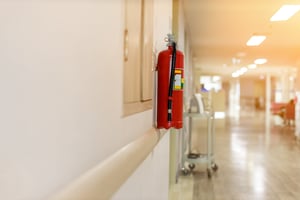
Fire and life safety is important for every business – but few places is it more important than in a health care organization.
Buildings such as hospitals or nursing homes pose unique challenges. Many of the people inside may be unable to evacuate in the case of a fire, due to medical conditions or immobility. Along with that, health care facilities often house potentially dangerous chemicals or gasses, such as oxygen. With this in mind, fire prevention is crucial – and it’s critical that any fires that do break out are promptly extinguished.
However, like with any business, it can be easier than you’d think to fall out of compliance with important fire and life safety measures. Below, we’ll walk you through the top five deficiencies we see in health care facilities and why it’s so important they get remedied immediately.
1. Sprinkler piping violations.
One of the key components to any fire and life safety system is the fire sprinklers. Sprinklers are connected throughout a building with piping that can transport water through the system as needed in the case of a fire. But, one of the most common deficiencies to find in a health care organization is mistreatment of sprinkler piping.
In hospitals, contractors will sometimes hang data cables, electrical cords or other types of tubing from fire sprinkler piping. Hospitals are constantly upgrading equipment or replacing items, and so when walls are opened, inexperienced contractors can make this mistake from time to time. It can be difficult to catch and fix, because oftentimes hospital leadership won’t even know this violation has occurred, since it’s behind closed walls.
It’s important that nothing hang from or on the tubing, because when water courses through the piping it requires special bracing to keep it stable and functional. Any extra weight on the piping can make it less effective or even cause it to fail.
The last thing you want during a fire is for the sprinklers not to work. This is one deficiency that needs to be fixed as soon as it is found.
2. Firewall safety issues.
A similar violation to the sprinkler issue is firewall safety deficiencies. The purpose of a firewall is to slow the spread of a fire from one area of a building to another, and to slow the spread of smoke. This not only gives people more time to escape, but also confines the fire to one area as much as possible.
In health care facilities, if sprinkler pipes have extra tubing or wires wrapped around them, larger holes are sometimes used to accommodate them between walls – rendering firewalls ineffective if they are affected. This can be a very costly repair at around $700 per issue that is found – and this deficiency definitely has an impact of staff and patient safety if left unfixed.
3. Improperly stored gas cannisters.
One semi-unique aspect to health care organizations is their need to have special chemicals and gasses for use with patients or during medical procedures. One of the most obvious is the need to store tanks of oxygen. While oxygen itself is not flammable, it is an oxidizer – meaning it can speed up the spread of a fire when stored in concentrated amounts.
There are many regulations around the storage of oxygen containers, and these rules vary based on the amount of gas, size of the cannister and other factors. NFPA also only allows a certain amount of gas to be stored within a certain area.
It’s important that health care facilities look into the regulations and make sure to align their particular situation with the various safety codes. Oftentimes, it even takes a team of people to make sure that all the regulations are followed properly.
This of course doesn’t account for other nonflammable gases, oxidizers and flammable gasses that a hospital might need to use and store. All must be considered when planning out the storage for these different materials.
4. Improper electrical distribution.
When it comes to actual fires in health care facilities, the most common cause of fires aside from cooking equipment is electrical distribution and lighting equipment, according to the National Fire Protection Association (NFPA). What that means is essentially that outlets or electrical sockets were overloaded past the point of compliance.
In places like hospitals, there’s so much equipment to plug in that it’s easy to exceed the electrical recommendations, or even to misuse items like extension cords. However, doing so can easily start a fire, and so it’s important to stay on top of compliance when it comes to outlets and general electrical distribution.
5. Blocked emergency exits.
A final common violation is among the simplest, and that’s keeping fire exits clear so they are accessible in the case of an emergency.
Health care organizations like hospitals have a lot of equipment. It can be easy to let that equipment pile up in places it doesn’t belong – including in front of fire exits. It is imperative that those exits remain clear however, so that if a fire does break out, people can exit quickly and efficiently. Additionally, exits should be clearly marked on maps and with proper emergency lighting and signage, so that visitors and patients are also aware of where to go in case of a fire or other emergency.
Staying in Compliance
Fire and life safety can be overwhelming for anyone – and when it comes to the special needs of a healthcare organization, it can be especially daunting. We at CertaSite are here to help. Our trained professionals will evaluate your building for deficiencies, come up with a plan for correcting them, and make sure that you maintain compliance through follow-up checks and more.




